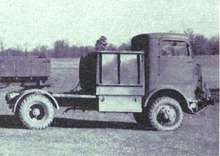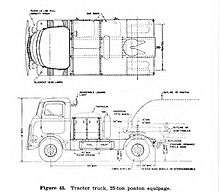Mack NJU 5-ton 4x4 truck
| Truck Tractor, Ponton, C. O. E., 5-6 ton, 4x4 (Mack Model NJU-1) | |
|---|---|
 Mack NJU-1 Ponton tractor | |
| Type | 5- to 6-ton 4x4 semi-tractor |
| Place of origin | United States |
| Production history | |
| Manufacturer | Mack Trucks |
| Produced | 1941-1942 |
| No. built | 692 (+8 NJU-2) |
| Variants | NJU-2 |
| Specifications (NJU-1[1]) | |
| Weight | 16,580 lb (7,520 kg) |
| Length | 19 ft 9 in (6.02 m) |
| Width | 8 ft (2.44 m) |
| Height | 9 ft 6 in (2.90 m) |
|
| |
| Engine |
Mack EN532 136 hp (101 kW) |
| Transmission | 5 speed x 2 range trf case |
| Suspension | Live axles on leaf springs |
The Mack NJU 5- to 6-ton 4x4 Ponton tractor (G639) was a semi-tractor designed to haul bridging equipment during World War II. Of the 700 built 119 were supplied to the British in Egypt, 8 were built with van bodies, and the rest were used as a substitute standard by the US Army.
History
In 1940 the US Army ordered 700 Mack 4 x 4 truck tractors, intended to tow pontoon-carrying semi-trailers. 694 were delivered in 1941 and the last 6 in 1942. An Autocar design was standardized by the US Army and only 700 NJUs were built.
692 NJU-1 tractors and 8 NJU-2 vans designed to tow topographical trailers were delivered.
In November 1941 119 semi-tractors were delivered to the British army in Egypt, where they bore War Department H-numbers.
Some NJU-1's went into French Army service post war.[2]
Design

The design was a militarized version of a civilian Cab Over Engine (COE) model, partly redesigned to make it 4WD. A Mack engine and transmission were matched with a Timken 2-speed transfer case and double-reduction axles. The EN532 engine was a 532 cu in (8.7 L) L-head inline 6 cylinder gasoline engine developing 136 hp (101 kW) at 2500 rpm. The 5-speed transmission drove the separate transfer case.[3]
A ladder frame had two live beam axles on leaf springs with a 155 inches (3.94 m) wheelbase. There was a 15,000 pounds (6,800 kg) winch behind the front bumper and a pintle hitch at the rear. A civilian type closed cab was used, right behind the cab was an open cargo box used to carry engineer tools, outboard motors, and other equipment.
Early semi-tractors and all vans used 9.75x20 tires, later semi-tractors had 12.00x20 tires. All trucks had dual rear tires. All trucks had full-air brakes.[4]
Gallery
 Mack NJU-1.1
Mack NJU-1.1 Mack NJU-1.3
Mack NJU-1.3 Mack NJU-1.6
Mack NJU-1.6
References
- ↑ Doyle, David (2014). Standard Catalog of U.S. Military Vehicles (2nd Edition). Krause Publications. p. 174. ISBN 0-87349-508-X.
- ↑ Vanderveen, Bart (1998). A record of military Macks in the Services and beyond. After the Battle. pp. 41–42. ISBN 1-870067-09-6.
- ↑ Crismon, Fred W (2001). US Military Wheeled Vehicles (3 ed.). Victory WWII Pub. p. 285. ISBN 0-970056-71-0.
- ↑ Vanderveen (1998).
- TM 5-270 Standard Stream Crossing Equipment. US War Dept. 1941. Retrieved 11 Dec 2016.
- TM 5-273 25 ton Ponton bridge Model 1940. US War Dept. 1942. Retrieved 11 Dec 2016.
- TM-10-1704 NJU-1
- TM 10-1705 NJU-1, -2, August 1941
External links
| Wikimedia Commons has media related to Mack NJU. |